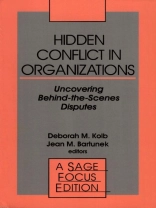Kolb and Bartunek′s Hidden Conflict in Organizations picks up where earlier works left off. . . . They provide some much-needed conceptual elaboration and empirical detail—elaboration and detail that earlier contextualist perspectives have not provided. . . . Despite being an edited volume, this book is surprisingly well focused and delicious to consume. . . . In directing our attention to the usual darkened and easily overlooked corners of organizational strife, this book provides a particularly compelling documentation of the social contextualist thesis. By documenting how minimal most organizational actors′ awareness of context is, coupled with active processes of denial, avoidance, and discounting, this book reminds us just how important it is to attend occasionally to the perceptual ground within which a figure is embedded. . . . The book does a beautiful job at articulating the importance of social context. —Negotiation Journal ‘What a timely and much needed volume for the field of conflict research! We believe wholeheartedly in the book′s continuous theme about there being a ′hidden′ side to conflict—a side which we feel is hidden to scholars, not to disputants or even practitioners. . . . The volume′s contributors clearly illustrate that unexplored gaps exist between the ′conflict′ studied by scholars and the multifaceted experience of those knee-deep in organizational conflict. . . . The reward for this focus is a richer and more dynamic picture of the experiences and functions of conflict in the organization. . . . This volume will and, indeed, should make us more aware of our own ways of constructing other′s disputes and, hence, the field′s current theories and prescriptions and proscriptions. This work will really have its impact when it significantly transforms our ways of studying and understanding conflict and eventually leads us to develop innovative and more effective ways for people to deal with (resolve or stimulate) their disputes in the workplace. We thank the editors and the authors for a wonderful beginning.’ —Journal of Organizational Behavior ‘Necessary reading for anyone interested in a comprehensive understanding of conflict theory. The dominant strength of this book is that it looks beyond the sometimes fraudulently tidy constructs of conflict theory to the messy and often irrational nature of social intercourse. . . . The succinct recapitulation of organizational theory that is relevant to conflict studies, and the extensive notes and bibliographical references in the book give the reader quick and effective access to the conflict resolution literature. The case-study approach makes the book attractive as supplementary reading.’ —Canadian Journal of Communication ‘Scholarly works that invite—or force—critical reexamination of assumptive frameworks are especially valuable. Hidden Conflict in Organizations is such a work. . . . The authors of the present volume go beyond early contributions, however, by providing much needed conceptual elaboration and empirical detail regarding precisely how conflicts remain hidden in organizations and the consequences of such ′hiddenness.′. . . The conceptual contributions made by these diverse individual efforts become most obvious when they are viewed against the backdrop of mainstream conflict theory and research. . . . Hidden Conflict does a service by reminding us also of the many ways in which conflict is embedded in larger, more complex social contexts and cultures. . . . This is the kind of book that reminds you of the pleasures of subtlety and that prompts a more nuanced understanding of a phenomenon. Good scholarly works, like good poetry, often bring to light lacunae. They allow one to feel the textures and contours of a landscape that often escape the eye. This is such a book.’ —The Academy of Management Review ‘The book represents a thoughtful collection of recent research and provocative thinking about very different kinds of disputes, mostly covert and informal, and how they are managed or left to fester in very different kinds of organizational settings. . . . This is a unique contribution to the study of conflict in organizations. . . . The authors have made a major contribution to a vast body of knowledge and opened up new avenues for applied research. . . . The authors are to be lauded for raising our awareness of hidden conflicts, their pervasiveness, and destructiveness in organizations of all kinds. . . . If you are a student of conflict and are seeking a scholarly work, this book is for you. It . . . will broaden your perspective, tell you something you didn′t know, and give you plenty to think about.’ —Personnel Psychology ‘This book lends a refreshing perspective on an old theme.’ —Stern′s HR Management Review ‘This is a much needed and delightful book about the hidden side of organizational life. The wide variety of settings in which hidden conflicts are observed and the high quality of the authors and their writing makes this not only an important but eminently readable book.’ Edgar H. Schein, Sloan School of Management, Massachusetts Institute of Technology ‘The individual essays are excellent and well written. . . . Each of the essays, in addition to descriptive material, offers a useful theoretical framework for understanding informal dispute resolution. The essays would provide useful supplemental reading for a course in dispute resolution theory and also could be used as examples in a practice course.’ —The Alternative Newsletter Conflict is a persistent fact of organizational life. In the midst of daily activities, disputes arise over a host of work and other issues. In contrast to the findings in traditional studies of conflict in organizations, most organizational conflict never becomes public. Rather, it is expressed during routine social and work-related interactions among members, and occurs in ways that reflect the specific organizational structures and cultures in which the interactions are embedded. This examination richly details some of these less public forms of conflict, which may take the form of avoidance, toleration, gossip, and vengeance. A collection of ethnographic studies of conflict management, Hidden Conflict in Organizations illustrates the use of these behind-the-scenes approaches in a wide variety of organizational settings, including a police department, start-up biotechnology firm, and labor-management negotiation. The contributors make it clear that, far from being an occasional occurrence in organizations, conflict is embedded in their very fabric. They draw on theory developed in other fields—disputing in legal contexts, deconstruction of texts, and ideological critique, among others—to examine conflictual processes in organizations. Adding a new dimension to the study of organizational conflict, this volume looks at the frequency of conflict, shows how conflicts are ‘really’ handled in organizations, and suggests that these conflicts can be better managed for organizational effectiveness.












